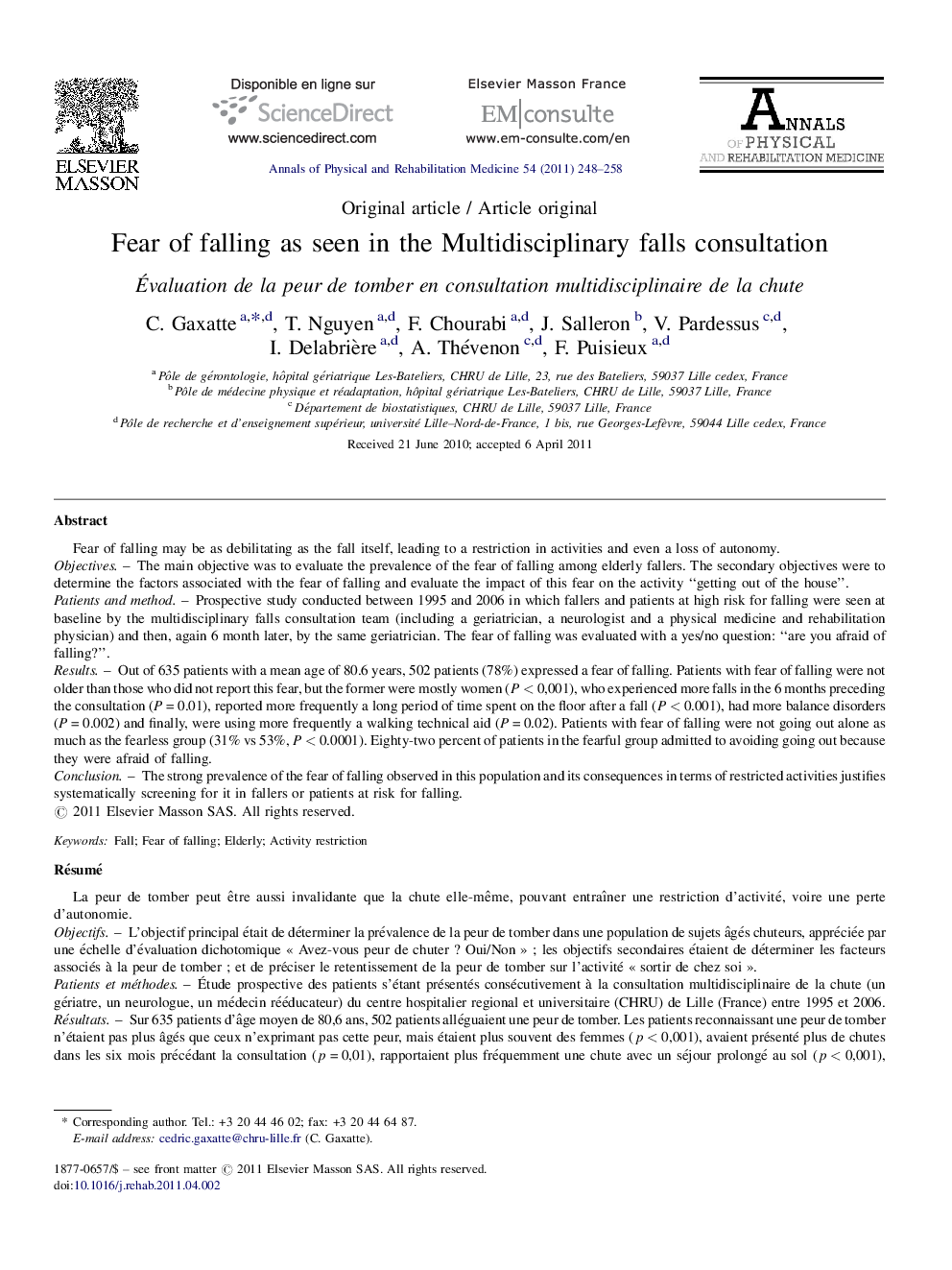| کد مقاله | کد نشریه | سال انتشار | مقاله انگلیسی | نسخه تمام متن |
|---|---|---|---|---|
| 4041258 | 1603337 | 2011 | 11 صفحه PDF | دانلود رایگان |

Fear of falling may be as debilitating as the fall itself, leading to a restriction in activities and even a loss of autonomy.ObjectivesThe main objective was to evaluate the prevalence of the fear of falling among elderly fallers. The secondary objectives were to determine the factors associated with the fear of falling and evaluate the impact of this fear on the activity “getting out of the house”.Patients and methodProspective study conducted between 1995 and 2006 in which fallers and patients at high risk for falling were seen at baseline by the multidisciplinary falls consultation team (including a geriatrician, a neurologist and a physical medicine and rehabilitation physician) and then, again 6 month later, by the same geriatrician. The fear of falling was evaluated with a yes/no question: “are you afraid of falling?”.ResultsOut of 635 patients with a mean age of 80.6 years, 502 patients (78%) expressed a fear of falling. Patients with fear of falling were not older than those who did not report this fear, but the former were mostly women (P < 0,001), who experienced more falls in the 6 months preceding the consultation (P = 0.01), reported more frequently a long period of time spent on the floor after a fall (P < 0.001), had more balance disorders (P = 0.002) and finally, were using more frequently a walking technical aid (P = 0.02). Patients with fear of falling were not going out alone as much as the fearless group (31% vs 53%, P < 0.0001). Eighty-two percent of patients in the fearful group admitted to avoiding going out because they were afraid of falling.ConclusionThe strong prevalence of the fear of falling observed in this population and its consequences in terms of restricted activities justifies systematically screening for it in fallers or patients at risk for falling.
RésuméLa peur de tomber peut être aussi invalidante que la chute elle-même, pouvant entraîner une restriction d’activité, voire une perte d’autonomie.ObjectifsL’objectif principal était de déterminer la prévalence de la peur de tomber dans une population de sujets âgés chuteurs, appréciée par une échelle d’évaluation dichotomique « Avez-vous peur de chuter ? Oui/Non » ; les objectifs secondaires étaient de déterminer les facteurs associés à la peur de tomber ; et de préciser le retentissement de la peur de tomber sur l’activité « sortir de chez soi ».Patients et méthodesÉtude prospective des patients s’étant présentés consécutivement à la consultation multidisciplinaire de la chute (un gériatre, un neurologue, un médecin rééducateur) du centre hospitalier regional et universitaire (CHRU) de Lille (France) entre 1995 et 2006.RésultatsSur 635 patients d’âge moyen de 80,6 ans, 502 patients alléguaient une peur de tomber. Les patients reconnaissant une peur de tomber n’étaient pas plus âgés que ceux n’exprimant pas cette peur, mais étaient plus souvent des femmes (p < 0,001), avaient présenté plus de chutes dans les six mois précédant la consultation (p = 0,01), rapportaient plus fréquemment une chute avec un séjour prolongé au sol (p < 0,001), présentaient plus souvent des troubles de l’équilibre (p = 0,002) et utilisaient plus souvent une aide technique de marche (p = 0,02). Les patients exprimant une peur de chuter sortaient moins souvent seul de chez eux (31 % vs 53 %, p < 0,0001). Quatre-vingt-deux pour cent des patients ayant peur de tomber admettaient éviter de sortir de peur de tomber.ConclusionLa forte prévalence de la peur de tomber observée ici et les conséquences de celle-ci en termes de restriction d’activité justifient sa recherche systématique chez un patient chuteur ou à risque de chute.
Journal: Annals of Physical and Rehabilitation Medicine - Volume 54, Issue 4, June 2011, Pages 248–258